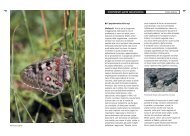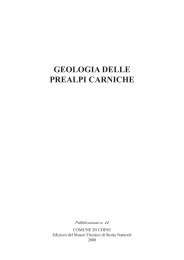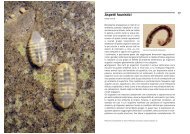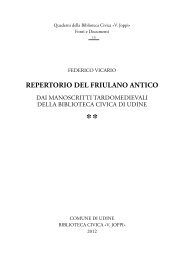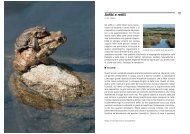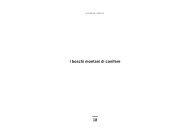Despite its inhospitable appearance and lack of any ... - Udine Cultura
Despite its inhospitable appearance and lack of any ... - Udine Cultura
Despite its inhospitable appearance and lack of any ... - Udine Cultura
Create successful ePaper yourself
Turn your PDF publications into a flip-book with our unique Google optimized e-Paper software.
64<br />
Species <strong>of</strong> genus Niphargus; top: N. costozzae; centre: N. longicaudatus; left, bottom: N. pescei (top)<br />
<strong>and</strong> N. transitivus (bottom); right, bottom: N. bajuvaricus gr<strong>and</strong>ii (ca. 3x)<br />
■ Amphipods<br />
This order <strong>of</strong> malacostracans includes<br />
several marine <strong>and</strong> freshwater species,<br />
sometimes sub-terrestrial, which<br />
colonised groundwater either directly<br />
from the sea, or from ancestors that<br />
once inhabited limnic surface water. In<br />
Italy, there are about 100 stygobiont<br />
species, almost all <strong>of</strong> which are<br />
endemic.<br />
Bogidiellids. Italian freshwaters host<br />
seven stygobiont species, most <strong>of</strong> Bogidiella sp. (ca. 10x)<br />
which are interstitial, occasionally<br />
euryhaline. Bogidiella albertimagni (in the Po Plain) <strong>and</strong> Bogidiella aprutina are<br />
the only continental species; the others are Tyrrhenian endemics, found in<br />
Sardinia <strong>and</strong> on the isl<strong>and</strong> <strong>of</strong> Elba.<br />
Gammarids. This family comprises exclusively surface species. Among those<br />
which only live in groundwater <strong>and</strong> are Italian endemics, two species <strong>of</strong><br />
Tyrrhenogammarus live in karstic aquifers in south-eastern Sicily<br />
(Tyrrhenogammarus catacumbae) <strong>and</strong> Sardinia (T. sardous). One species <strong>of</strong><br />
Longigammarus (L. planasiae) has recently been collected from a well on the<br />
limestone isl<strong>and</strong> <strong>of</strong> Pianosa (Tuscan archipelago), <strong>and</strong> a specialised species,<br />
Ilvanella inexpectata, is known to inhabit alluvial aquifers on the isl<strong>and</strong> <strong>of</strong> Elba<br />
<strong>and</strong> in Tusc<strong>any</strong>.<br />
Hadziids. The genus Hadzia - presumably a Tethyan relict - has four Italian<br />
species. Hadzia fragilis stochi, an endemic subspecies with delicate, elongated<br />
appendages, has been described in alkaline water in the karstic area <strong>of</strong> Trieste<br />
<strong>and</strong> river Isonzo. Hadzia minuta inhab<strong>its</strong> karstic waters in Salento, <strong>and</strong> H.<br />
adriatica has been collected from pools in Apulia. Another species, which is<br />
still under description, was recently found in southern Sardinia.<br />
Niphargids. The genus Niphargus (more than 250 known species, 70 <strong>of</strong> which<br />
live in Italy; size between 3 <strong>and</strong> 40 mm) have complex, controversial<br />
taxonomy, which is currently being revised by means <strong>of</strong> molecular biology<br />
techniques. Their distribution area includes most <strong>of</strong> Europe (except for the<br />
Iberian Peninsula <strong>and</strong> the upper northern areas) <strong>and</strong> stretches east towards<br />
Iran. This suggests that the genus colonised European surface freshwater<br />
from the basins <strong>of</strong> the Tertiary Paratethys, <strong>and</strong> later moved into groundwater.<br />
However, fossils similar to present species have recently been found in Baltic<br />
65




